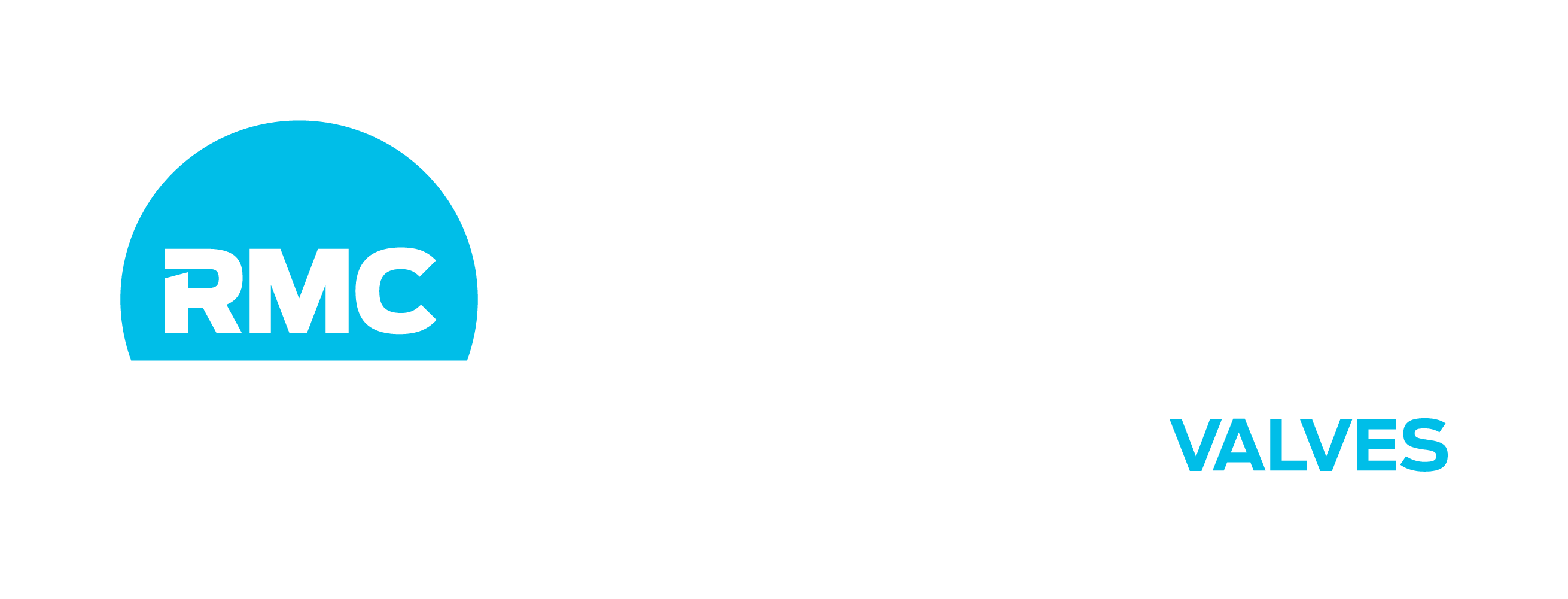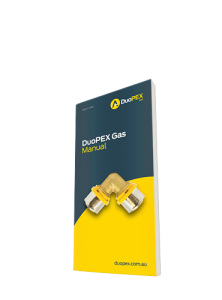DuoPEX Gas
Properties
The DuoPEX Gas pipe and fitting system is designed to make every job quick and easy. It provides a revolutionary alternative for the professional plumber and gas fitter.
DuoPEX Gas Pipe
DuoPEX Gas pipe is a multi-layer or composite pipe system.
DuoPEX Gas pipe consists of:
- An inner layer of cross-linked polyethylene (PEX)
- An aluminium layer
- An outer layer of cross-linked polyethylene (PEX)
- Inner and outer adhesive layers
Do not use pipes that have kinks, cuts, deep scratches, squashed ends, imperfections or have been in contact with contaminating substances. Such pipe should be cut out and replaced, as these conditions may affect the integrity of the system.
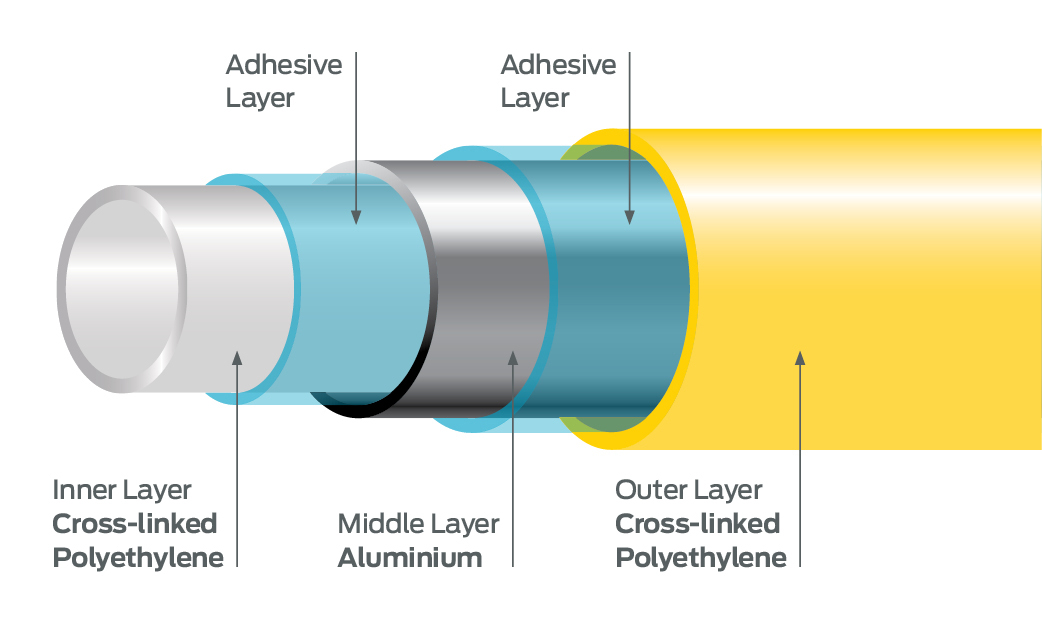
DuoPEX Gas pipe has been tested and certified in accordance with AS 4176.
DuoPEX Gas Fittings
DuoPEX Gas fittings are manufactured from dezincification resistance (DR) brass with a stainless steel crimp ring and joined to the pipe using a precision and specific crimping tool.
To increase joint performance all DuoPEX Gas crimp fittings are characterised by a plastic holding ring which has three important functions:
- As a locating ring that matches the DuoPEX Gas jaws for a perfect crimp position
- It allows the installer to visually check when the pipe is correctly fitted on the fitting
- The fitting has a yellow plastic holding ring to identify the fitting is for gas installations only
The DuoPEX Gas fittings and DuoPEX Water fittings have different O-Ring compositions that are specific to their purpose.
The yellow holding ring indicates O-Rings for gas and the blue holding rings indicates O-Rings for water. Use the correct fitting for each application. This must be strictly adhered to.
Pipe and fittings are joined and sealed thanks to the stainless steel crimp ring mechanical deformation (2). This deformation is achieved by using the special DuoPEX Gas jaws.
- Multi-Layer Pipe
- Stainless Steel Crimp Ring
- O-Rings
- Plastic Sight Ring
- DR Brass Fitting
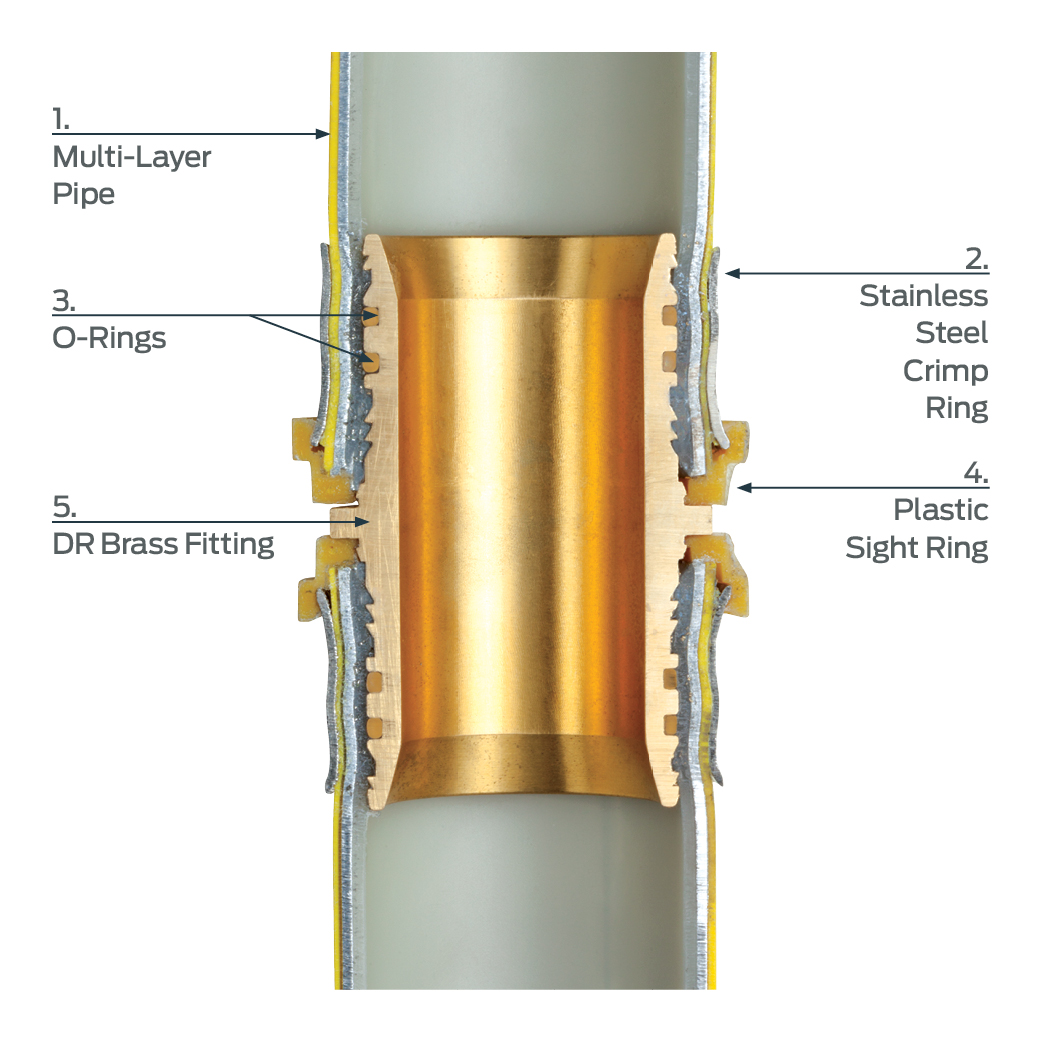
The Plastic Sight Ring aids in locating the jaws in the correct crimp position and features a witness hole to check the pipe has been fully inserted in the fitting.
Data Sheet
| Dimension | 16×2 | 20×2 | 26×3 | 32×3 | 40×3.5 | 50×4 | 63×4.5 |
|---|---|---|---|---|---|---|---|
| Coefficient of Linear Thermal Expansion (mm/m x K) | 0.026 | 0.026 | 0.026 | 0.026 | 0.026 | 0.026 | 0.026 |
| Thermal Conductivity (W/M x K) | 0.45 | 0.45 | 0.45 | 0.45 | 0.45 | 0.45 | 0.45 |
| Water contents (1/m) | 0.113 | 0.201 | 0.314 | 0.531 | 0.855 | 1.385 | 2.29 |
| Radius of curvature without aids (mm) | 5 x d | 5 x d | – | – | – | – | – |
| Radius of curvature with bending spring (mm) | 2 x d | 3 x d | – | – | – | – | – |
| Radius of curvature with bending tool (mm) | – | – | 3.6 x d | 3.6 x d | 4.0 x d | 4.0 x d | 4.5 x d |
| Pipe roughness K (mm) | 0.007 | 0.007 | 0.007 | 0.007 | 0.007 | 0.007 | 0.007 |
| Coil Length | 50, 100 | 50, 100 | 50 | 50 | – | – | – |
| Coil Dimensions (mm) inside x outside x width |
610 x 740 x 115 510 x 740 x 120 |
550 x 780 x 190 | 550 x 780 x 190 | 940 x 1200 x 150 | – | – | – |
| Weight per coil (kg) | 5.5 | 15 | 15 | 21 | |||
| Metres per length | 5 | 5 | 5 | 5 | 5 | 5 | 5 |
Bend Properties
Forming Stability
After bending, the DuoPEX Gas pipe will remain stable, due to the aluminium layer. In many cases, thanks to this characteristic, it is possible to prefabricate assemblies before delivery to the site.
Minimum Bending Radii
Bending can be made manually, however if tighter bends are required, bending tools may be used.
The bending process on DuoPEX Gas pipe must not result in either indentations or deformations on the inside of the pipe bend. Damage to the PEX layer of the DuoPEX Gas pipe may effect the integrity of the system.
| Nominal diameter (da x s) |
Bending radius (R) without aid |
Bending radius (R) with bending spring |
Bending radius (R) with bending tool |
|---|---|---|---|
| 16 x 2.0 | 5 x da | 2.0 x da | |
| 20 x 2.0 | 5 x da | 3.0 x da | |
| 26 x 3.0 | 3.6 x da | ||
| 32 x 3.0 | 3.6 x da | ||
| 40 x 3.5 | 4.0 x da | ||
| 50 x 4.0 | 4.0 x da | ||
| 63 x 4.5 | 4.5 x da |
Note: All measurements in mm unless otherwise stated.
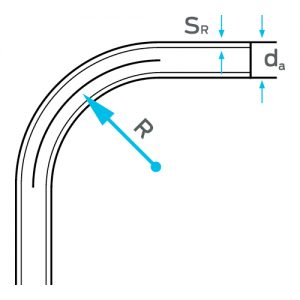
Thermal Properties
Thermal Changes in Length
Heating and cooling cause pipe length changes. The coefficient of expansion of DuoPEX Gas composite pipes is 0.026 mm/m x k. For further information on Linear Expansion Tables and other expansion bend examples contact your DuoPEX representative.
| Example Temperature | |
|---|---|
| Differential ΔT | 50 k |
| Pipe length L | 5 m |
| Coefficient of expansion a | 0.026 mm/m.K |
| Linear expansion ΔL | 6.5 mm |
| ΔL | = a x L x ΔT = 0.026mm/m.K x 5 m x 50 K = 6.5 mm |
Thermal conductivity = 0.45 W/M x K
Fire and Excessive Heat
- Keep DuoPEX Gas pipe a minimum of 500mm from sources of high heat, PEX such as heating appliances and flues from heating appliances
- Keep DuoPEX Gas pipe 1500mm from slow combustion type stoves and flues used to heat hot water or cooking (wet back type)
- Leave 300mm minimum space between DuoPEX Gas pipe and light fittings or other electrical fixtures
- DuoPEX Gas pipe should not be positioned within 150mm of gas or central heating vents or flues
- Where fire collars or the like are required, installers should contact the manufacturer of those products to ensure they have certification for MLP construction
Spacing of Supporting Devices
| Pipe Dimension | Max Pipe clip clearance |
|---|---|
| 16 x 2.0 | 1000 |
| 20 x 2.0 | 1250 |
| 26 x 3.0 | 1500 |
| 32 x 3.0 | 2000 |
| 40 x 3.5 | 2000 |
| 50 x 4.0 | 2500 |
| 63 x 4.5 | 2500 |
Note: All measurements in mm unless otherwise stated.
See also AS/NZS 5601. Synthetic clips must be used.
UV and Chemical Resistance
UV Resistance
DuoPEX Gas pipes must be protected against direct sunlight or UV radiation. Consequently, DuoPEX Gas pipes must be covered during transport or storage if they have been removed from their original packaging. When DuoPEX Gas pipes are used in a protective sleeve, adequate UV protection is assured during the installation phase. Furthermore, jackets made from insulating material can undertake the function of UV protection with DuoPEX Gas pipes. See DuoPEX Gas product list in this manual for appropriate sleeving.
It is best practice to ensure that piping is installed out of direct sunlight – protected or not protected.
Gas Standard AS/NZS 5601
4.11.4 - Composite pipe installed above ground shall be protected against degradation from exposure to ultraviolet light.
Note: A typical means of protection is sleeving or wrapping with a suitable protective material
Chemical Resistance
The chemical properties of polyethylene are significantly improved by cross-linking. Multi-layer pipe with cross-linked polyethene has been approved for use in AS/NZS 5601. This includes Natural Gas and LPG. For specific gases other than these, please contact your DuoPEX representative.
DuoPEX Gas pipes are resistant to the following media:
- Concrete, plaster, mortar and cement
- Disinfectants and cleaning agents according to DVGW worksheet W 291 and DIN 2000
- All natural potable water constituents
- Corrosion – protection agents according to DIN 1988 Part 4
DuoPEX Gas pipes must be protected against:
- Direct contact with bitumen or bitumen strips
- Greases, solvents and oils
- Contaminated areas as defined by AS/NZS 5601 and AS/NZS 3500
If the DuoPEX Gas system is used in areas where, for example, aggressive gases, permanently acting moistures or building materials containing chlorine are to be encountered, the fittings must be protected using suitable jacketing.
It is also best practice to protect fittings with suitable jacketing when in contact with screed, concrete, mortar, plaster or burial in contaminated soil.
